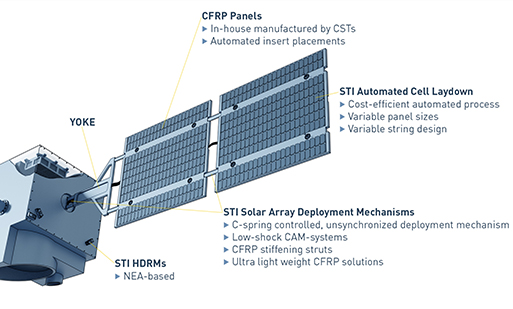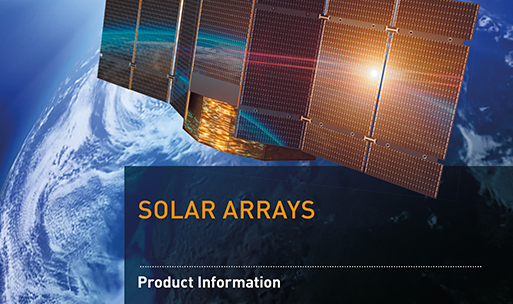SpaceTech Solar Arrays for Space Applications
- One-stop solution for the full scope of solar arrays:
- body-mounted panels
- single hinge deployable arrays
- multi-hinge deployable solar array wings including deployment electronics & HDRM, solar array drive, mechanisms as well as photovoltaic assemblies on panels
- Highly automated, yet flexible in-house production of panels and photovoltaic laydown and our unique deployment mechanisms
- Benefit from fast development and highly cost-efficient designs, fitting perfectly to your needs
- We serve NewSpace mega-constellations as well as the most demanding institutional missions
- Examples of our activities are the solar arrays for OneWeb Satellites, York Space Systems and a multitude of institutional missions, including GökTürk-2, Sentinel-5p, Sentinel-6, EUCLID, CHIME, CO2M, CRISTAL, LSTM and PLATO.
Over the last years, SpaceTech has developed a novel multi-hinge deployment mechanism technology suitable of a wide range of solar array sizes from less than 0.5 m² (XS) to more than 6 m² (XL) per panel. Salient feature of the mechanism is the controlled unsynchronized deployment using C-spring hinges of standardized sizes, enabling robust, light weight and cost-effective solutions for various solar power needs. This technology is - together with our automated PVA laydown technology - greatly enhancing the market for our products. With it we were able to already acquire several contracts ranging from news space to highest reliability institutional missions.
Links
Copernicus
Find more details in our solar array brochure:
Download the STI solar array brochure
SpaceTech solar arrays – selected projects and milestones
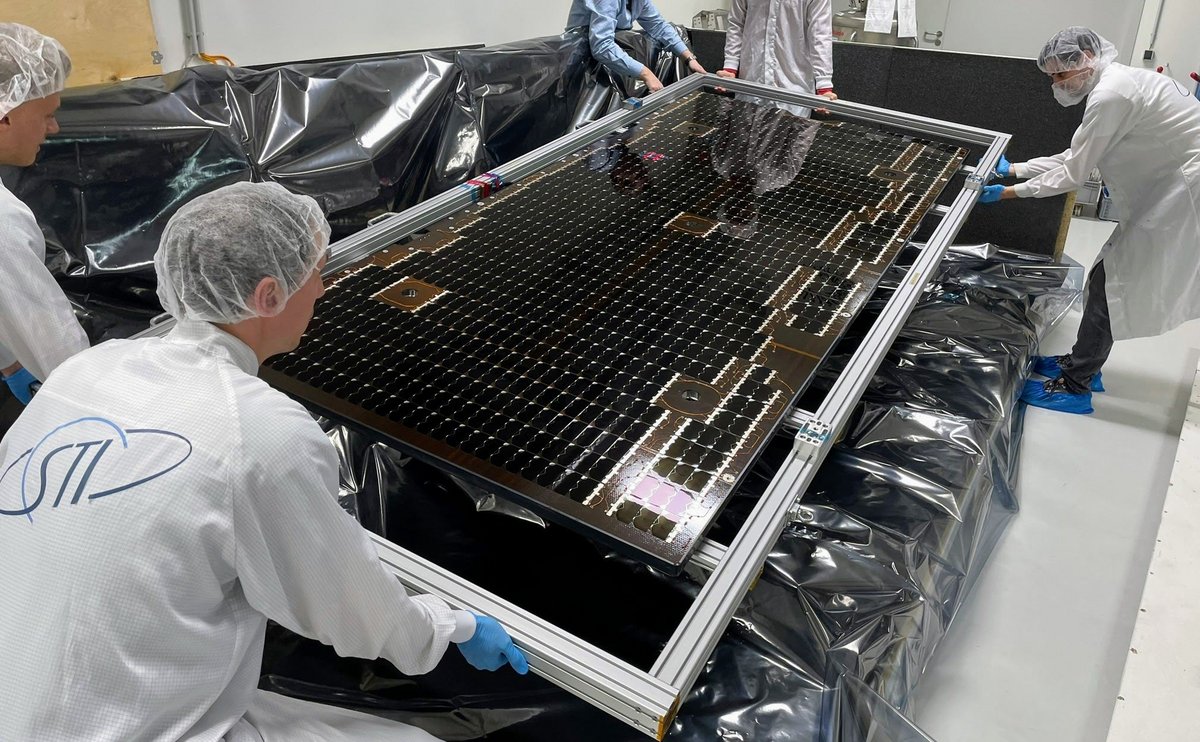
PLATO (PLAnetary Transits and Oscillations of stars mission) mission goal
The mission goal is to find and study a large number of extrasolar planetary systems, with emphasis on the properties of terrestrial planets in the habitable zone around solar-like stars.
SpaceTech development for PLATO
After being selected as provider of the EUCLID sunshield, PLATO is the next ESA science mission with STI involvement.
SpaceTech has shipped the first four solar array panels for the European Space Agency - ESA PLATO spacecraft mission to Thales Alenia Space.
These panels are being developed in a cooperation of Thales Alenia Space, Beyond Gravity & STI for the PLATO mission of ESA, with OHB SE as mission prime. STI signs responsible for the Photovoltaic Assembly (PVA), making use of a proprietary highly automated PVA laydown process. It is one of the largest solar arrays ever made by STI.
PLATO mission launch
The Launch is planned for 2026.
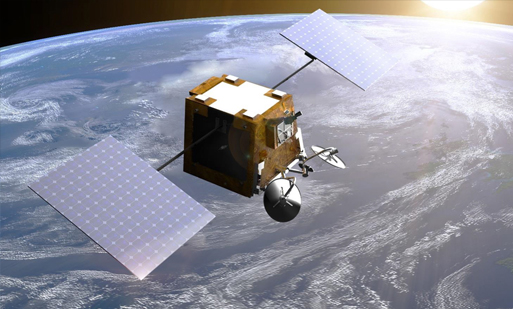
Proving our capability of design, manufacturing and delivery of 1000 solar array deployment mechanisms on time, making use of our serial production facilities, SpaceTech got contracted by Airbus OneWeb Satellites also deliver the complete solar arrays for their satellites.
These solar arrays are going to start their ultimate job in orbit with one of the next OneWeb satellite launches.
SpaceTech solar array serial production
Together with the solar array deployment mechanism (SADM), this second serial production for Airbus OneWeb Satellites is another important milestone for SpaceTech.
We are very happy with the success of this great joint effort and cooperation with our customer and are proud of our team at STI.
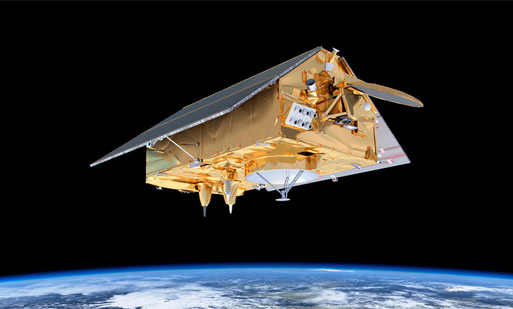
The US-European Sentinel-6 radar altimeter mission for ocean surface topography study aims to monitor sea-level rising because of climate change. Sentinel-6 is part of the Copernicus program.
SpaceTech development for JASON CS/Sentinel-6
SpaceTech manufactured and delivered the solar arrays (PVA by Leonardo, panels by Airborne) for the two Sentinel 6 (Jason CS) satellites. Each satellite set consist of two body mounted and two deployable panels combined in two solar array wings.
Being four of the biggest solar arrays produced at STI, each panel measures 3.6 m length by 1.1-1.2 m width.
Sentinel-6 launch
After almost 1.5 years of spacecraft preparation, the first satellite was launched in November 2020 with the SpaceX Falcon 9 rocket from Vandenberg, California, US.

York’s S-CLASS industrial-grade platform is a standardized 3-axis stabilized spacecraft capable of supporting 85kg payloads with up to 3,500W peak (enhanced power system), while reducing the cost of manufacture by an order of magnitude. The S-CLASS spacecraft is fully compatible with all launch vehicles, including ground and air-launched, and ground segment providers. When optioned with York’s cloud-based mission tasking and operations center, an ultra-low-cost solution is available on demand for next generation data collection and analytics companies.
SpaceTech solar arrays for York Space Systems
SpaceTech developed and manufactured the body mounted solar arrays for the S-CLASS, making use of our fully automated PVA laydown process.
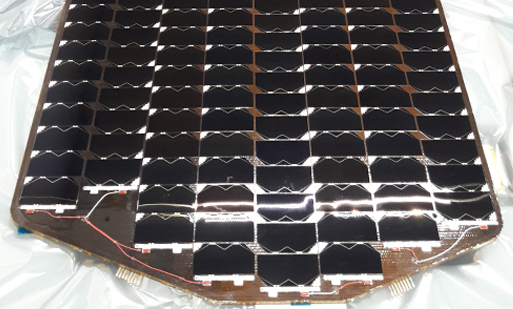
The three young Israeli engineers Yariv Bash, Kfir Damari and Yonatan Winetraub founded the non-profit company Space-IL to land an unmanned spacecraft on the moon in order to increase knowledge in Israel and inspire the next generation in Israel and around the world to choose to study science, technology, engineering and mathematics founded.
The landing robot was supposed to place the Israeli flag and to analyze the magnetic field. The generated data should be used for research of the moon genesis.
A milestone for Israel as well as a milestone for the worldwide space industry and the so-called New Space market as it was the first privately-owned spacecraft landing on the moon.
SpaceTech solar array panels for Beresheet
SpaceTech delivered the solar array panels for the Beresheet spacecraft, verifying the new STI cut-down Inserts, GFRP-Flex brackets and the (hot-press manufactured) solar panels in SPACE. STI is proud to having contributed to this challenging mission and happy that our cost-efficient and smart solutions to the space industry are – once again - being selected for the private New Space market – indicating the competitiveness of our solutions.
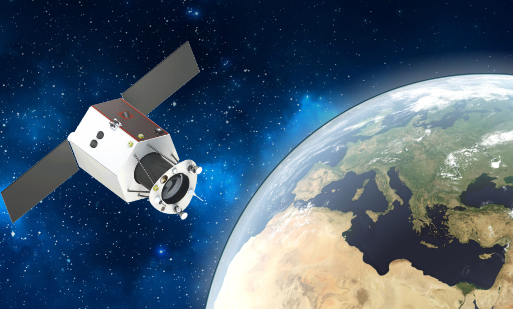
The IMECE Program consists of two main projects:
IMECE Satellite Subsystems Development Project
IMECE Satellite Platform Development Project
SpaceTech developments for IMECE
SpaceTech develops the deployable solar arrays including solar deployment electronics for IMECE.
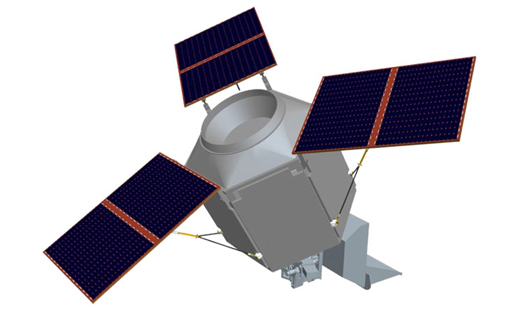
SpaceTech has developed and delivered the deployable solar array system for the ESA mission Sentinel-5 Precursor under a contract by Astrium U.K. Ltd. The sytem consists of:
- 3 solar panels including the photovoltaic assembly
- Solar array deployment mechanisms
S5P launch
The flight models of the deployable solar arrays were delivered to Airbus in September 2014. The Sentinel-5 Precursor satellite has been launched on 13 October 2017 on a Rocket launch vehicle from the Cosmodrome in Plesetsk (Russia).
In the context of SpaceTech’s support contract with the Taiwanese space agency NSPO for the FormoSat-5 spacecraft, SpaceTech signed responsible for the layout and delivery of the solar array of the spacecraft. FORMOSAT-5 is an earth observation satellite mission with a ground resolution of approximately 2 m, realized as a Taiwan domestic development.
FormoSat-5 earth observation satellite SpaceTech solar array system
The SpaceTech solar array system consists of two nearly identical panels with photovoltaic assemblies that are deployed in orbit. The development of the solar array is strongly connected with the contracted delivery of an omni-directional sun sensor (OSS) using the same type of cells and substrate and being partially integrated into the solar panels, as well.
FormoSat-5 launch
The two proto-flight models were delivered to Taiwan in spring 2012. FormoSat-5 has been successfully launched on 24th of August 2017 from Air Force Base Vandenburg on a Falcon 9 (SpaceX). This is a major milestone both for NSPO as being the first earth observation satellite designed by Taiwan and for STI as a provider of cost-efficient high quality satellite systems.
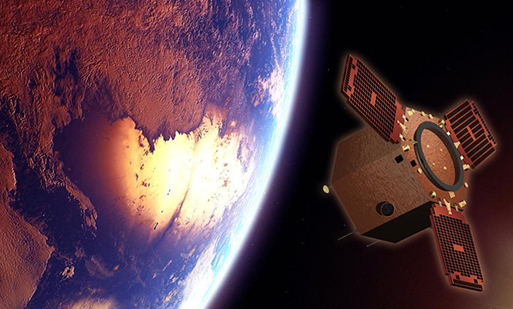
Against strong international competition, SpaceTech has been awarded a contract by the Turkish government institute TÜBITAK UZAY to deliver the GökTürk-2 solar array system consisting of:
- 3 solar panels including the photovoltaic assembly
- Solar Array Deployment Mechanisms (SADM)
- Hold-Down and Release Mechanism (HDRM)
- Pyro Drive Module (PDM) electronics executing the deployment sequence of the mechanism
GökTürk-2 solar array key features
- Rattle-free
- Very low friction
- High torque margins
- No latching shocks
GökTürk-2 launch
The qualification and flight models of the solar array system have been delivered to Turkey in 2010 and 2011, respectively. The satellite has been launched and the solar array successfully deployed in December 2012.
SpaceTech was selected by Airbus DS as supplier of the solar array for their Synthetic Aperture Radar SAR satellite
STI tasks include mechanical, thermal and electrical design as well as the manufacturing and test one of the most powerful STI solar array.
The photovoltaic assembly has a practically undisturbed cell layout thanks to optimized mechanical fixation design allowing an exceptionally high fill ratio.
In addition, the solar array relies on the latest cell technology available on the market.
SpaceTech solar array for SAR satellite
These two key factors allow STI to offer the maximum power per available area. The solar array has been equipped with a passive thermal design principle, based on a Multi-Layer Insulation (MLI) and special mechanical brackets.
Thus, minimizing radiative and conductive coupling between satellite and solar array.
Key features of SAR satellite
- Maximum power per available area
- Body fixed panel with high thermal decoupling from S/C
- Latest cell generation
The solar array was delivered to Airbus DS in August 2018.
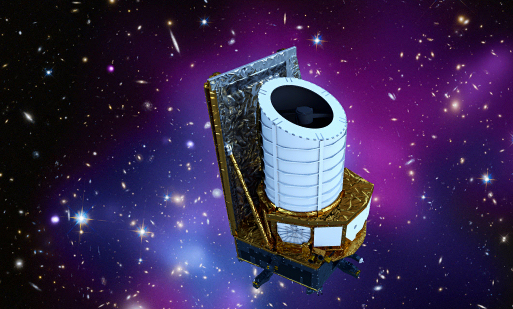
Euclid is an ESA medium class space mission in the Cosmic Vision 2015-2025 program. The Euclid mission aims at understanding why the expansion of the universe is accelerating and what is the very nature of the source of this acceleration that physicists refer to as dark energy.
SpaceTech developments for Euclid
- Body mounted solar array
- Sunshield
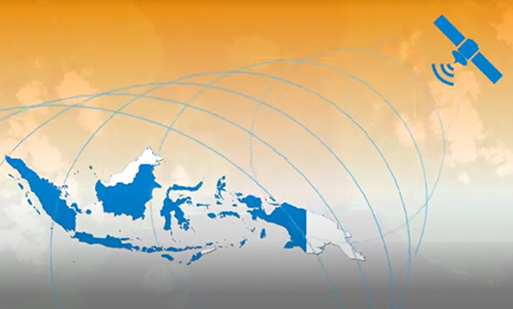
Indonesia’s space agency LAPAN is planning to operate an experimental microsatellite constellation.
LAPAN is developing two microsatellites, Lapan A4 and Lapan A5. These will add to LAPAN’s first three remote sensing satellites, Lapan A1, A2, and A3, which were launched in 2007, 2015, and 2016.
All satellites will work towards national development goals – Lapan A4 will carry a multispectral imager and will be used for maritime surveillance.
SpaceTech development for LAPAN A4 satellite
SpaceTech developed the body mounted solar arrays with automated cell laydown.
Links
Find more details about LAPAN A4


